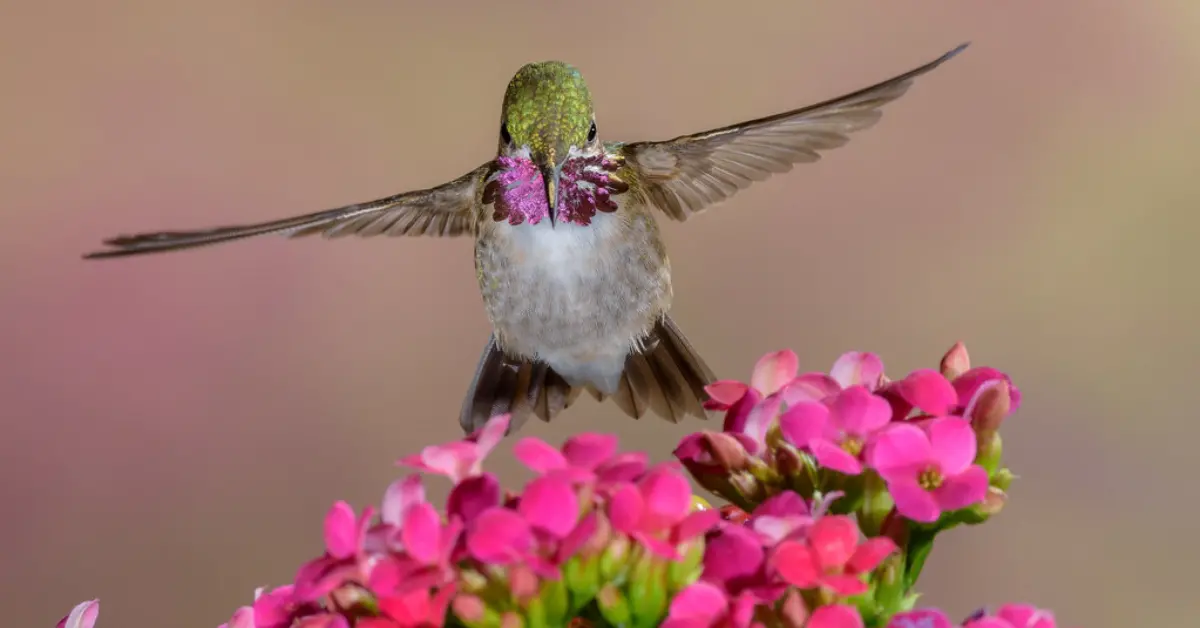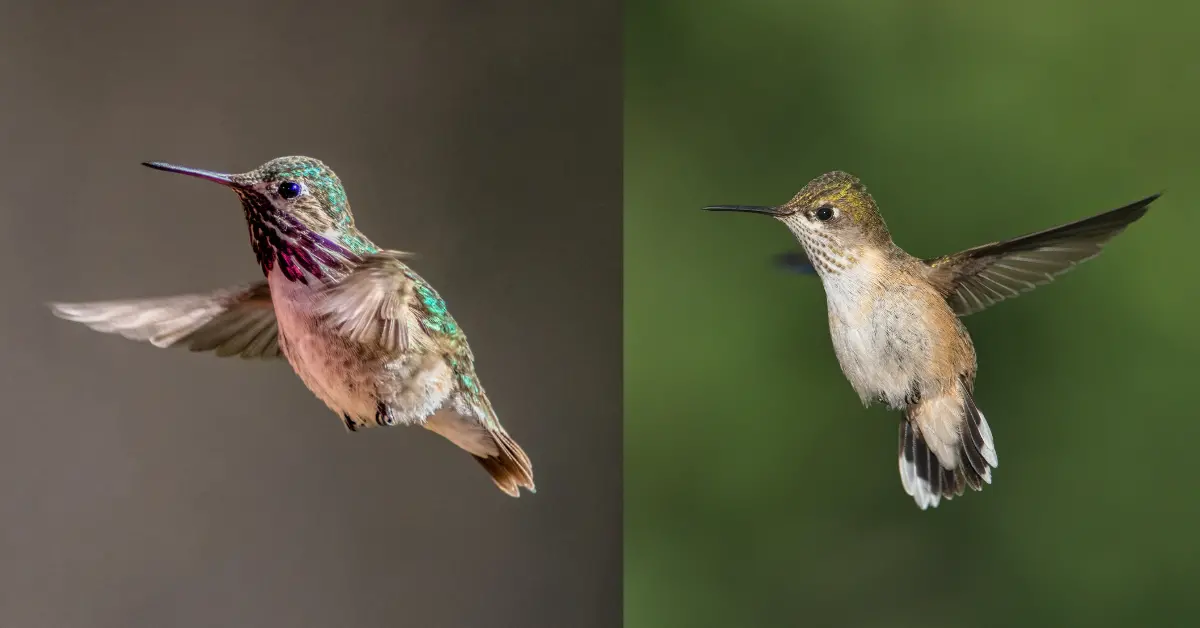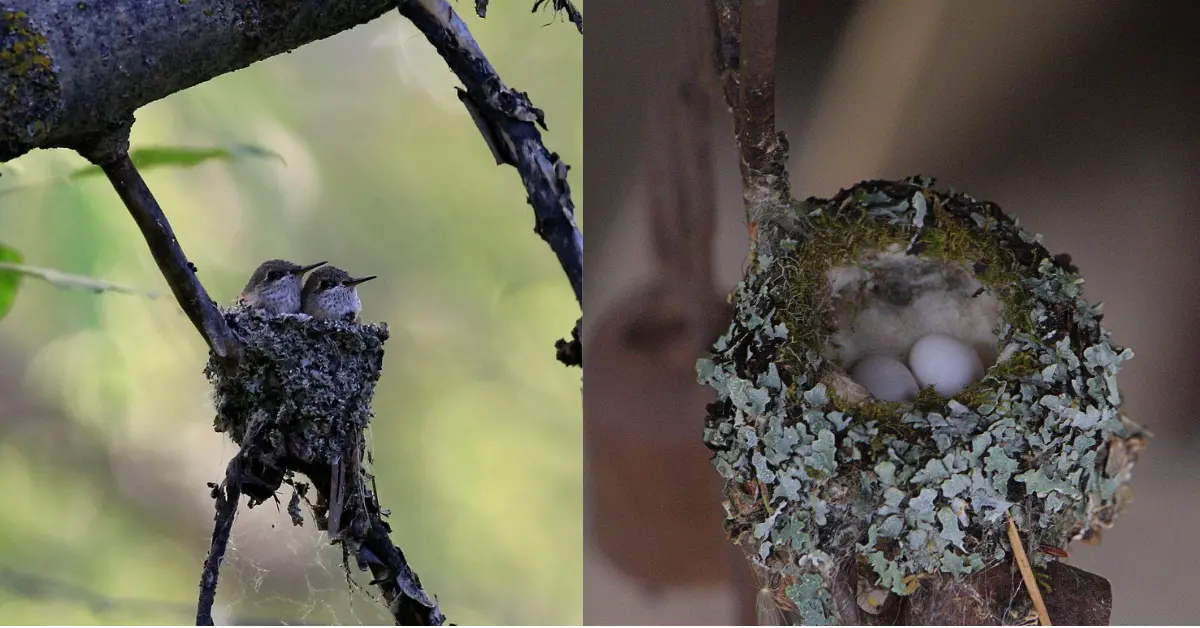A tiny, iridescent bird hovers motionless as it delicately sips nectar from a bright pink flower. Its shimmering green back and brilliant magenta chest flash in the sunlight. It can only be one thing: the Calliope hummingbird.

These miniature marvels are a treat for birdwatchers across western North America. But it’s not just their size or dazzling colors that make them special – there’s more much to this tiny bird than meets the eye.
Calliope hummingbirds have a small compact build and a hunched posture. Both males and females are sparkling green above, but males also sport a greenish vest on their chest. The dazzling magenta throat streaks of the male are a key identifier for this species. Females wear a softer look, with a peachy wash on the front and speckled green on the throat. When trying to tell them apart from similar species like the rufous hummingbird, look for the shorter bill and tail of the Calliope – a distinguishing feature for both males and females.

You’ll find them in western North American during the breeding season, from California to British Columbia and eastwards into Idaho, Montana, Wyoming and Utah. In fall, they follow the Rocky Mountains southward and migrate all the way to southwestern Mexico – where this species spends the winter.
Top Ten Cool Facts About Calliope Hummingbirds
So what makes this little hummingbird so extraordinary? Read our 10 favourite facts about Calliope hummingbirds below to find out:
1. Calliope Hummingbirds are the Smallest Birds in North America
Calliope hummingbirds are in fact the tiniest avian you can find in North America.
They measure about 3 inches in length and weigh only a tenth of an ounce – that’s about the same weight as a ping pong ball!
Their hunched posture and compact build make them appear even smaller. You’ll almost certainly need binoculars for a proper look.
2. They are Named After the Muse of Epic Poetry
The name “Calliope” comes from Ancient Greek mythology. Calliope was the muse of eloquence and epic poetry, said to have inspired works like Homer’s Iliad and Odyssey.
“Calliope” means “beautiful voice” in Greek. Ironically, though, the Calliope hummingbird’s vocalizations are more of a simple, unmelodic chirp than an epic ballad.
3. They’re the World’s Smallest Long-distance Migratory Bird
Despite its size, this bird undertakes an epic migration. Travelling up to 5,000 miles, these birds journey from their summer breeding grounds in North America to wintering sites in southern Mexico.

For something that could fit in the palm of your hand, that’s really a remarkable feat.
4. They Nest in the Mountains
These birds typically breed in mountainous areas – around 4,000 to 11,000 feet above sea level. However, in some regions like the Columbia river basin, they are known to nest as low as 600 feet.
They usually choose breeding areas near rivers or streams.
5. Male Calliope Hummingbirds are VERY territorial
Tiny… but fierce.
Male Calliopes don’t shy away from a fight. They fiercly defend their breeding territory – even chasing off birds as large as red-tailed hawks.
You’ll often see them perched on bare branches of alder or willow trees, keeping watch. While they expend a large effort into protecting food sources and attracting mates, they play no role in helping with the nest or young.
6. Males Use Aerial Acrobatics to Impress Females
When the male Calliope hummingbird isn’t defending his territory, he is performing.

He will spend about 6% of his time trying to woo a mate with elaborate flight displays. One of the flashiest is the “U-shaped dive”: the male rises up to 100 feet in the air, then plunges in a dramatic arc before soaring up again.
He also does a “shuttle display”: hovering in front of the female while pulsing his wings and flaring his throat feathers.
7. Their Tiny Nests Look Like Pine Cones
Females usually build their nests in conifer trees, often choosing spots on branches where pine cones once grew.
Using spider silk to bind plant down and lichens, she creates a nest just 1.5 inches wide and 1 inch tall. The resulting nest blends seamlessly into the folioge and can easily be mistaken as part of a lichen-covered branch, or a pine cone.
Inside, she normally lays two eggs, each only half an inch long.

8. They Can Live for Nearly a Decade
The oldest recorded Calliope hummingbird was a female banded in Idaho in 2007 and found again in 2014 – over eight years old. For a bird this tiny, that’s an impressive lifespan.
However, most hummingbirds don’t die of old age. Instead, natural and human-caused factors like cold weather, habitat loss and predation by domestic cats are more likely to cause their mortality.
9. You Can Attract Calliope Hummingbirds with a Feeder
If you live within the Calliope hummingbird’s breeding or migratory range, you may be able to attract one into your yard.
Set out a sugar water feeder (see our fool-proof guide to feeding hummingbirds here), and plant nectar-rich tubular flowers.

In addition to nectar, Calliope hummingbirds also eat small insects like flies, bees and beetles. They catch these insects in mid-air by flying out from a perch – in a similar fashion to flycatchers.
10. Their Population is Stable – but Still Vunerable
With an estimated global population of around 4.5 million individuals, the Calliope hummingbird is currently listed as a species of Least Concern.
However, as their entire population winters in a relatively small region of southwestern Mexico, they are considered vulnerable to habitat loss and extreme weather in that area.
In Summary: The Calliope Hummingbird
The Calliope hummingbird may be North America’s smallest bird, but it’s full of suprises – from its epic migration to its feisty territorial behavior.
Look out for this bird in mountainous regions of western North America, and in particular see if you can spot the male using a willow or alder branch perch to watch out for intruders in his territory!
